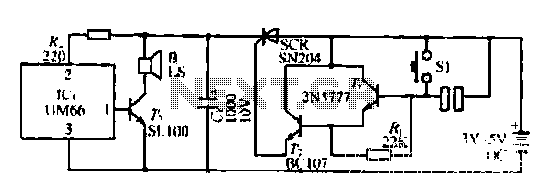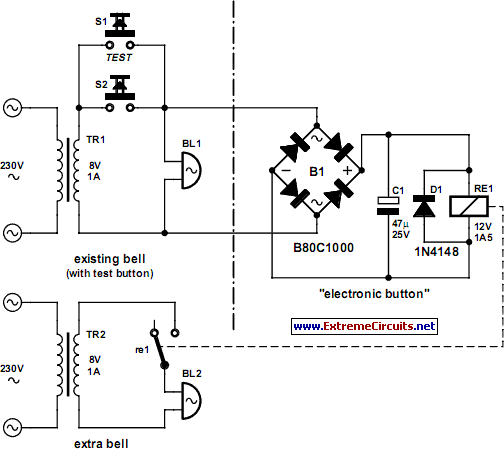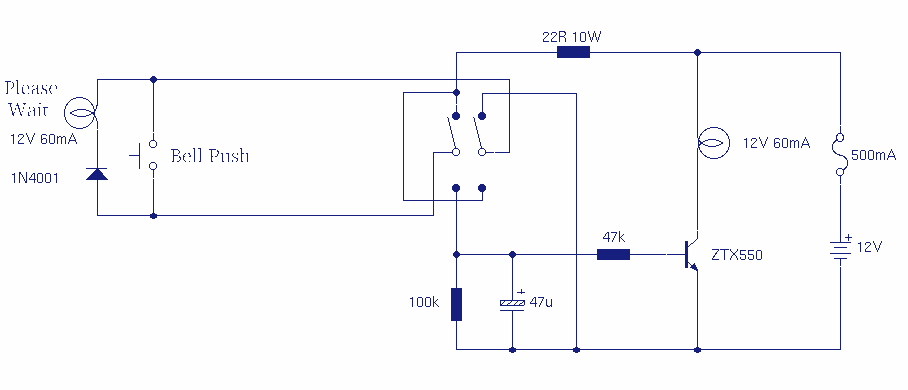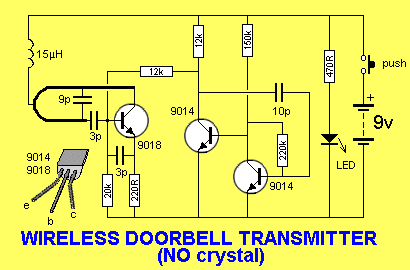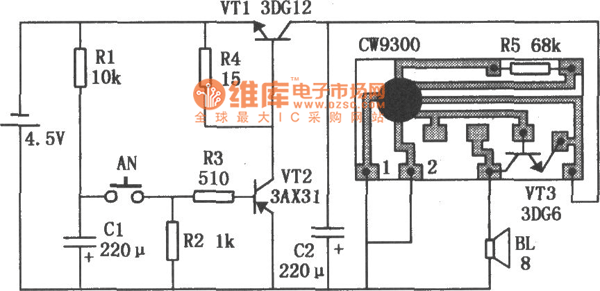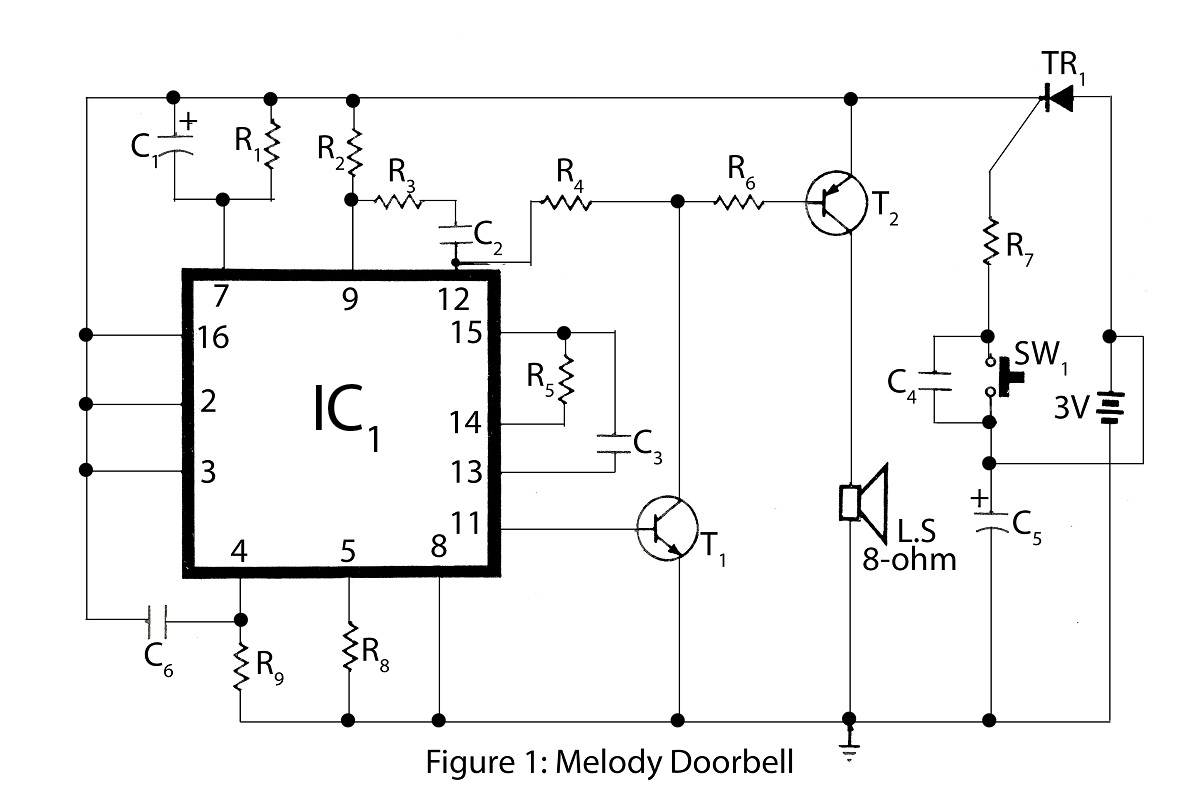
Doorbell for the Deafs
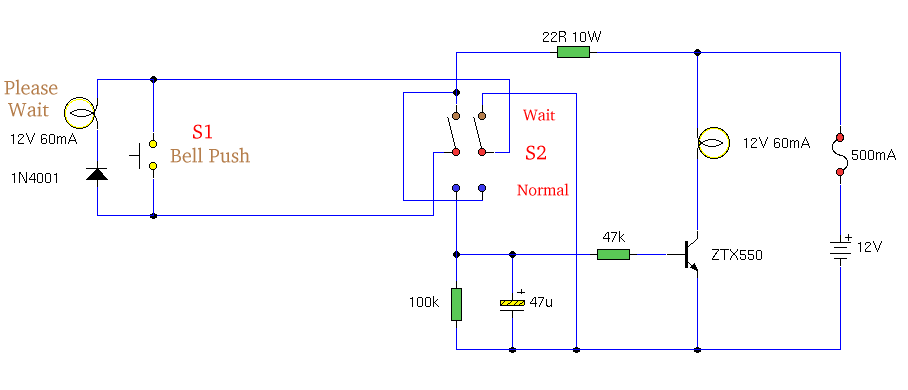
This circuit provides a delayed visual indication when a doorbell switch is pressed. Additionally, a double pole double throw (DPDT) switch can be activated from within the house to light a lamp at the doorbell switch. The lamp can illuminate the words "Please Wait" for individuals with walking difficulties. The circuit utilizes standard two-wire doorbell cable or loudspeaker wire. In parallel with the doorbell switch (S1), there is a 1N4001 diode and a 12-volt, 60mA bulb. The bulb is optional and serves to assist those who may take longer to answer the door. By flicking the switch inside the house, the bulb will illuminate the label stating "Please Wait" either at the doorbell switch or nearby. The DPDT switch redirects the doorbell supply to the lamp, while a 22-ohm resistor is included to limit current flow in the event that the doorbell switch (S1) is pressed while the lamp is illuminated. This resistor must be rated for 10 watts, and a 0.5 Amp fuse is incorporated to protect against short circuits. When switch S2 is in the up position (indicated by brown contacts), it will activate the remote doorbell lamp. In the down position (indicated by blue contacts), the circuit operates in its normal state, illuminating the lamp inside the house. When switch S1 is pressed, it charges a 47µF capacitor, which subsequently operates a transistor to light the lamp. Given that the doorbell switch is only pressed momentarily, the charge on the capacitor decays slowly, resulting in the lamp remaining on for several seconds. To extend the duration of illumination, the capacitor value can be increased.
The circuit design includes a doorbell switch (S1) that initiates the operation of the entire system. Upon pressing S1, the 1N4001 diode ensures that current flows in the correct direction, protecting the circuit from potential reverse voltage that could damage the components. The 12-volt, 60mA bulb serves as a visual aid, with its illumination indicating the need for attention at the door. The optional nature of the bulb allows for flexibility in installation, depending on user requirements.
The DPDT switch (S2) is a critical component that allows for user control over the circuit's output. When in the up position, the switch connects the power supply to the remote lamp, ensuring visibility from outside. Conversely, when in the down position, the circuit powers the internal lamp, providing a clear indication within the house. The use of a 22-ohm resistor is essential for managing current flow, particularly in scenarios where both the doorbell switch and the lamp might be activated simultaneously. This resistor's 10-watt rating is crucial for preventing overheating and potential damage.
The integration of a 0.5 Amp fuse adds a layer of safety by interrupting the circuit in the event of a short circuit, thus safeguarding the components from excessive current. The 47µF capacitor plays a pivotal role in creating the delayed illumination effect. It charges rapidly when the doorbell switch is pressed and discharges slowly, allowing the lamp to remain lit for a brief period after the switch is released. For users requiring extended illumination, the capacitor value can be adjusted, providing customization based on specific needs.
Overall, this circuit design combines functionality and safety, offering a practical solution for enhancing doorbell systems, particularly for those with mobility challenges.This circuit provides a delayed visual indication when a door bell switch is pressed. In addition, a DPDT switch can be moved from within the house which will light a lamp in the door bell switch. The lamp can illuminate the words "Please Wait" for anyone with walking difficulties. The circuit uses standard 2 wire doorbell cable or loudspeaker wir e. In parallel with the doorbell switch, S1, is a 1N4001 diode and a 12 volt 60mA bulb. The bulb is optional, it may be useful for anyone who is slow to answer the door, all you need to do is flick a switch inside the house, and the bulb will illuminate a label saying Please Wait inside the doorbell switch or close to it. The double pole double throw switch sends the doorbell supply to the lamp, the 22 ohm resistor is there to reduce current flow, should the doorbell switch, S1 be pressed while the lamp is on.
The resistor needs to be rated 10 watts, the 0. 5 Amp fuse protects against short circuits. When S2 is in the up position (shown as brown contacts), this will illuminate the remote doorbell lamp. When down, (blue contacts) this is the normal position and will illuminate the lamp inside the house.
Switch S1 will then charge the 47u capacitor and operate the transistor which lights the lamp. As a door bell switch is only pressed momentarily, then the charge on the capacitor decays slowly, resulting in the lamp being left on for several seconds. If a longer period is needed then the capacitor may be increased in value. 🔗 External reference
The circuit design includes a doorbell switch (S1) that initiates the operation of the entire system. Upon pressing S1, the 1N4001 diode ensures that current flows in the correct direction, protecting the circuit from potential reverse voltage that could damage the components. The 12-volt, 60mA bulb serves as a visual aid, with its illumination indicating the need for attention at the door. The optional nature of the bulb allows for flexibility in installation, depending on user requirements.
The DPDT switch (S2) is a critical component that allows for user control over the circuit's output. When in the up position, the switch connects the power supply to the remote lamp, ensuring visibility from outside. Conversely, when in the down position, the circuit powers the internal lamp, providing a clear indication within the house. The use of a 22-ohm resistor is essential for managing current flow, particularly in scenarios where both the doorbell switch and the lamp might be activated simultaneously. This resistor's 10-watt rating is crucial for preventing overheating and potential damage.
The integration of a 0.5 Amp fuse adds a layer of safety by interrupting the circuit in the event of a short circuit, thus safeguarding the components from excessive current. The 47µF capacitor plays a pivotal role in creating the delayed illumination effect. It charges rapidly when the doorbell switch is pressed and discharges slowly, allowing the lamp to remain lit for a brief period after the switch is released. For users requiring extended illumination, the capacitor value can be adjusted, providing customization based on specific needs.
Overall, this circuit design combines functionality and safety, offering a practical solution for enhancing doorbell systems, particularly for those with mobility challenges.This circuit provides a delayed visual indication when a door bell switch is pressed. In addition, a DPDT switch can be moved from within the house which will light a lamp in the door bell switch. The lamp can illuminate the words "Please Wait" for anyone with walking difficulties. The circuit uses standard 2 wire doorbell cable or loudspeaker wir e. In parallel with the doorbell switch, S1, is a 1N4001 diode and a 12 volt 60mA bulb. The bulb is optional, it may be useful for anyone who is slow to answer the door, all you need to do is flick a switch inside the house, and the bulb will illuminate a label saying Please Wait inside the doorbell switch or close to it. The double pole double throw switch sends the doorbell supply to the lamp, the 22 ohm resistor is there to reduce current flow, should the doorbell switch, S1 be pressed while the lamp is on.
The resistor needs to be rated 10 watts, the 0. 5 Amp fuse protects against short circuits. When S2 is in the up position (shown as brown contacts), this will illuminate the remote doorbell lamp. When down, (blue contacts) this is the normal position and will illuminate the lamp inside the house.
Switch S1 will then charge the 47u capacitor and operate the transistor which lights the lamp. As a door bell switch is only pressed momentarily, then the charge on the capacitor decays slowly, resulting in the lamp being left on for several seconds. If a longer period is needed then the capacitor may be increased in value. 🔗 External reference
